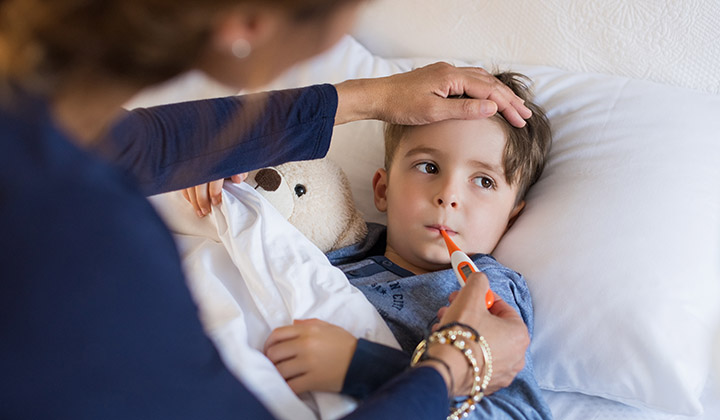Kids sick again? What to do about those pesky bugs going around

If it feels like the kiddos in your life are constantly coming down with something, it’s probably not your imagination. In the first 2 years of life, it is common for kids in daycare to be sick with respiratory illnesses 10 to 12 times per year. After age 6, it is still common for kids to get sick 6 to 8 times per year. Nobody wants their children to be under the weather that much, but it is normal and generally not cause for worry. That said, we would like to put parents’ minds at ease with a few tips and tricks to deal with those pesky colds, flus and other common illnesses.
What kinds of illnesses do kids commonly pick up at daycare and school?
Kids in a group setting are prone to highly contagious illnesses like the common cold, flu, COVID-19, respiratory syncytial virus (RSV), strep throat and conjunctivitis (pink eye). These illnesses are spread by respiratory droplets through coughing or sneezing or through hand-to-face contact with a hand or object that has been contaminated with the virus. It is possible to have multiple illnesses at once and different strains of the same illness in close succession.
Does getting sick build kids’ immunity?
Immunity is temporarily boosted after a child is sick, but it doesn’t apply widely and it doesn’t last long term. Immunity to the specific virus they contracted can increase but it does not protect them from contracting other viruses or bacterial infections.
What can be done to reduce how often they’re getting sick?
The best forms of prevention we have are things most of us know. We just need reminders to keep good habits.
- Wash your hands. Make sure everyone in your home washes their hands regularly with warm, soapy water for at least 20 seconds (sing the birthday song twice). Carry hand sanitizer when you’re not near a sink.
- Keep sick kids home. For the wellbeing of your child and their classmates, they should be fever free for 24 hours without any type of fever reducer before returning to school or daycare. This gives them adequate time to recover and reduces the likelihood of spreading illness.
- Clean high touch surfaces. Disinfect the items your kid touches most, especially if other family members touch them, too. Some common shared objects are phones, tablets, remotes, toys, doorknobs, light switches, faucets and toilet flush handles.
- Ask your child’s teacher how you can help keep the classroom healthy. Some teachers are responsible for buying supplies like disinfectant cleaner or hand sanitizer. They may appreciate a donation or something else. Just ask.
- Wear a mask when sick. For kids age 2 years and up, masks help prevent the spread of all respiratory viruses, not just COVID-19.
- Avoid sharing food and drinks. Don’t drink out of the same cups, use the same utensils, eat off each other’s plates or otherwise share food and drinks.
- Don’t kiss your kids on the lips. Opt for hugs or other ways of showing affection when family members are sick.
- Encourage healthy eating and sleeping. Getting adequate rest and plenty of nutrients helps prevent illness and shorten its duration when it does happen.
What helps when they do get sick?
As much as you may want to, it’s not possible to prevent every common illness that comes your child’s way. It is possible, however, to help them manage symptoms until they feel better.
Important note: If your child has labored breathing, see a health care provider immediately.
- For any common illness: Fluids and rest help the body do what it needs to do to recover. Avoiding dehydration and fatigue are important ways to get the body back to health. Zinc or vitamin C can be given to help reduce the duration of illness.
- For sore throat: Take some honey by itself, or add to a warm drink.
- For cough: A cool mist humidifier helps break up phlegm. If a cough prevents sleep, prop the child up with pillows to reduce post-nasal drip and ease breathing. Do not use cough suppressants for children.
- For headache: Children’s acetaminophen or ibuprofen can be taken as directed.
- For body aches: Warm baths can ease aches, as well as children’s acetaminophen or ibuprofen.
- For fever: If your child’s fever is 100 degrees Fahrenheit or lower, do not give them a fever reducer. Let the fever do its job. A fever reducer can be used for higher temperatures.
- For conjunctivitis: Apply a wet compress to the eyes. Visit a health care provider to see if an antibiotic ointment or drops are appropriate.
Dealing with frequent illness is not the most fun part of parenting, but you can get through it. You’ve got this. We hope our tips help you feel equipped next time your kiddo brings home whatever’s going around at school.

